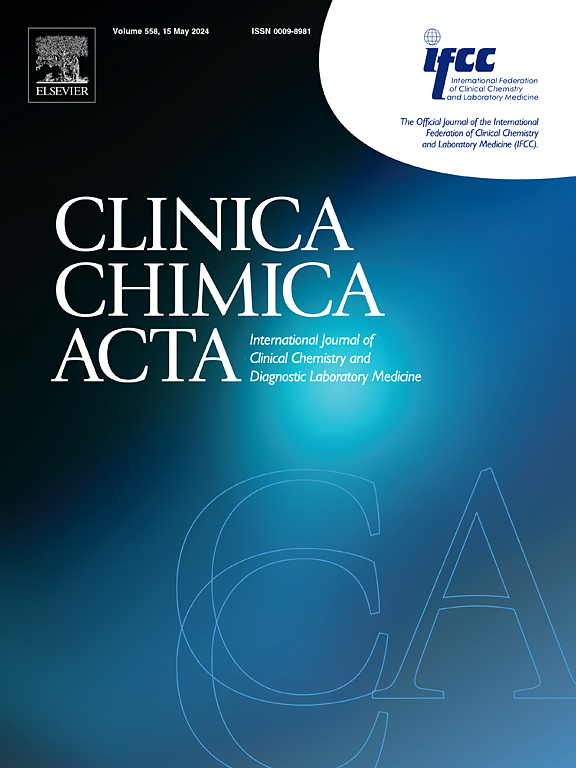肺癌液体活检中的外泌体 ncRNA。
IF 3.2
3区 医学
Q2 MEDICAL LABORATORY TECHNOLOGY
引用次数: 0
摘要
外泌体非编码 RNA(ncRNA)已成为推动和治疗肺癌(LC)的重要因素。利用外泌体非编码 RNA(exo-ncRNA)开发的液体活检为诊断、预测和治疗肺癌提供了一种令人鼓舞的方法。本综述将深入探讨外泌体 ncRNA 作为早期诊断指标和 LC 治疗途径的双重功能。外泌体是包括癌细胞在内的各种细胞分泌的微小囊泡,通过传递 ncRNA 实现细胞间的连接。这些 ncRNA 包括环状 RNA、长 ncRNA 和 microRNA,参与调节基因表达和细胞功能。在乳腺癌中,某些外源性 ncRNA 与肿瘤的发展、扩散和治疗耐药性有关,因此可作为液体活检中的非侵入性指标。此外,通过抑制有害的 ncRNA 或恢复抑制肿瘤的 ncRNA 的活性,靶向这些 ncRNA 为创新治疗方法提供了潜力。这篇综述强调了提取和分析外ncRNA的最新进展、它们在LC治疗中的实际应用,以及将这些发现转化为临床应用的挑战和前景。通过对外部 ncRNA 现状的详细分析,我们旨在强调其在 LC 诊断和治疗中的巨大潜力。本文章由计算机程序翻译,如有差异,请以英文原文为准。
Exosomal ncRNAs in liquid biopsies for lung cancer
Exosomal non-coding RNAs (ncRNAs) have become essential contributors to advancing and treating lung cancers (LCs). The development of liquid biopsies that utilize exosomal ncRNAs (exo-ncRNAs) offers an encouraging method for diagnosing, predicting, and treating LC. This thorough overview examines the dual function of exo-ncRNAs as both indicators for early diagnosis and avenues for LC treatment. Exosomes are tiny vesicles secreted by various cells, including cancerous cells, enabling connection between cells by delivering ncRNAs. These ncRNAs, which encompass circular RNAs, long ncRNAs, and microRNAs, participate in the modulation of gene expression and cellular functions. In LC, certain exo-ncRNAs are linked to tumour advancement, spread, and treatment resistance, positioning them as promising non-invasive indicators in liquid biopsies. Additionally, targeting these ncRNAs offers potential for innovative treatment approaches, whether by suppressing harmful ncRNAs or reinstating the activity of tumour-suppressing ones. This review emphasizes recent developments in the extraction and analysis of exo-ncRNAs, their practical applications in LC treatment, and the challenges and prospects for translating these discoveries into clinical usage. Through this detailed examination of the current state of the art, we aim to highlight the significant potential of exo-ncRNAs for LC diagnostics and treatments.
求助全文
通过发布文献求助,成功后即可免费获取论文全文。
去求助
来源期刊

Clinica Chimica Acta
医学-医学实验技术
CiteScore
10.10
自引率
2.00%
发文量
1268
审稿时长
23 days
期刊介绍:
The Official Journal of the International Federation of Clinical Chemistry and Laboratory Medicine (IFCC)
Clinica Chimica Acta is a high-quality journal which publishes original Research Communications in the field of clinical chemistry and laboratory medicine, defined as the diagnostic application of chemistry, biochemistry, immunochemistry, biochemical aspects of hematology, toxicology, and molecular biology to the study of human disease in body fluids and cells.
The objective of the journal is to publish novel information leading to a better understanding of biological mechanisms of human diseases, their prevention, diagnosis, and patient management. Reports of an applied clinical character are also welcome. Papers concerned with normal metabolic processes or with constituents of normal cells or body fluids, such as reports of experimental or clinical studies in animals, are only considered when they are clearly and directly relevant to human disease. Evaluation of commercial products have a low priority for publication, unless they are novel or represent a technological breakthrough. Studies dealing with effects of drugs and natural products and studies dealing with the redox status in various diseases are not within the journal''s scope. Development and evaluation of novel analytical methodologies where applicable to diagnostic clinical chemistry and laboratory medicine, including point-of-care testing, and topics on laboratory management and informatics will also be considered. Studies focused on emerging diagnostic technologies and (big) data analysis procedures including digitalization, mobile Health, and artificial Intelligence applied to Laboratory Medicine are also of interest.
 求助内容:
求助内容: 应助结果提醒方式:
应助结果提醒方式:


